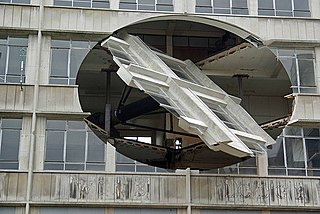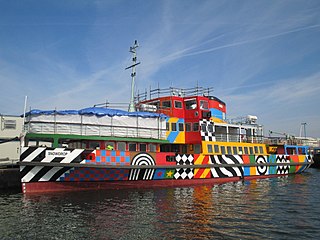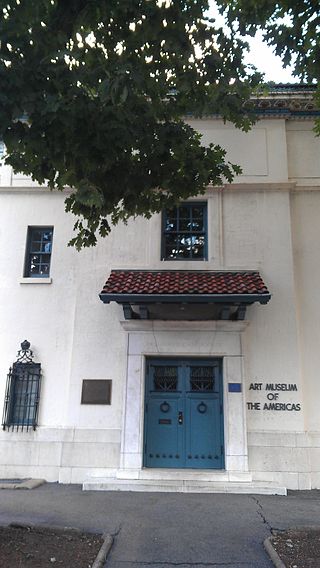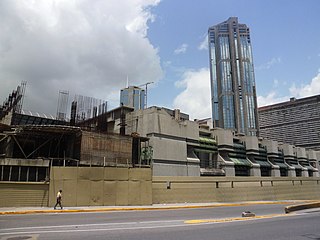Related Research Articles

Liverpool Biennial is the largest international contemporary art festival in the United Kingdom.

Jesús Rafael Soto was a Venezuelan op and kinetic artist, a sculptor and a painter.
Venezuelan art has a long history. Initially dominated by religious motifs, art in Venezuela began emphasizing historical and heroic representations in the late 19th century, a move led by Martín Tovar y Tovar. Modernism took over in the 20th century. Notable Venezuelan artists include Arturo Michelena, Cristóbal Rojas, Armando Reverón, Manuel Cabré, the kinetic artists Jesús-Rafael Soto and Carlos Cruz-Diez, the Meta-realism artist Pajaro and Yucef Merhi.

The Dazzle ships of the 14–18 NOW project are artworks created to commemorate the work of the artists and artisans who developed and designed the dazzle camouflage used in the First World War by ships as a defence against U-boat attack.
Carlos Cruz may refer to:

Jaime Gili is a visual artist. He has been based in London since 1996.
Denise René was a French art gallerist specializing in kinetic art and op art.

Carlos Cruz-Diez was a Venezuelan artist said by some scholars to have been "one of the greatest artistic innovators of the 20th century."

Art Museum of the Americas (AMA), located in Washington, D.C., is the first art museum in the United States primarily devoted to exhibiting works of modern and contemporary art from Latin America and the Caribbean. The museum was formally established in 1976 by the Organization of American States (OAS) as the Museum of Modern Art of Latin America. Artists represented in the AMA's permanent collection include Carlos Cruz-Diez, Candido Portinari, Pedro Figari, Fernando de Szyszlo, Amelia Peláez, and Alejandro Obregón.

The National Art Gallery also known as Gallery of National Art is located in the Plaza Morelos area of Caracas, Venezuela. The museum opened in May 1976. In 2009 it moved to a new building designed by Carlos Gómez de Llerena, Venezuela's largest museum building.

Informalism or Art Informel is a pictorial movement from the 1943–1950s, that includes all the abstract and gestural tendencies that developed in France and the rest of Europe during the World War II, similar to American abstract expressionism started 1946. Several distinguishing trends are identified within the movement such as lyrical abstraction, matter painting, New Paris School, tachisme and art brut. The French art critic Michel Tapié coined the term "art autre" in the homonymous book published in 1952 in relation to non-geometric abstract art. It was instrumental in improving the concept of abstract art in France during the Early 1950s. Its use in the expression of political ideologies in South America during the Early 1950s was quite common, as it was seen as the main way to show support for the changing political climate.

Sculpture Park is a sculpture garden at the foot of Nutibara Hill in Medellín, Colombia and the first of its kind in the country. The park contains 10 modern and abstract sculptures by famous Colombian and international artists such as Edgar Negret (Colombia), Otto Herbert Hajek (Germany), and Sergio de Camargo (Brazil).

Plaza Venezuela is a public square located in Los Caobos neighborhood, Caracas, Venezuela. It was inaugurated in 1940 and is situated in the geographic center of Caracas.
Louis Stern Fine Arts is an art gallery located at 9002 Melrose Avenue in West Hollywood, California, in the heart of the city’s Avenue of Art and Design.

Felipe Pantone is an Argentine-Spanish contemporary artist. He was born in Buenos Aires, Argentina and raised in southeast Spain. Pantone's body of work is based in kinetic art, installations, graffiti, and design, characterized by “use of bold colors, geometrical patterns, and Op Art elements.” His combinations recall “bright colored typography, 80s Synth pop music, and SMPTE color bars on the TV.”

Carlos Medina is a Venezuelan-born France-based visual artist primarily known for his minimalist geometric compositions and significant spatial interventions, which combine sculpture techniques and plastic arts. He has had over twenty exhibitions in museums worldwide, and his works are present in collections, and public spaces, in countries such as Italy, France, Belgium, Yugoslavia, the United States, South Korea, Austria, Hungary, Spain, Mexico, Chile, Argentina, Colombia, Panama, Costa Rica, and Venezuela.
The 2018 Bolivian Primera División season was the 41st season of Bolivia's top-flight football league and the first season under División de Fútbol Profesional management. Bolívar were the defending champions, having won the 2017 Clausura tournament.

The Paez Medal of Arts is a decoration awarded by The Venezuelan American Endowment for the Arts (VAEA) that is presented once a year to an individual or group that has had an impact and contributed to excellence, growth, support and the proliferation of the arts in Venezuela and the United States. It is named in honor of José Antonio Páez, leader of the Independence of Venezuela, who lived in exile the last years in New York, where he became a philanthropist.
Pedro de Oraá was a Cuban contemporary visual artist, best known for his contributions to the Cuban abstract movement of Concretism in the 1950s and his involvement in the group Los Once in 1956 and the co-founding of Los Diez Pintores Concretos known simply as, Los Diez with fellow artists Loló Soldevilla and Sandú Daríe, in 1957. He was an art critic, poet, designer, translator, and the beneficiary of many awards such as the Distinction for National Culture in 1995, the National Book Design Prize in 2011 and the National Prize for Plastic Arts in 2015.
Los Diez Pintores Concretos was a mid 20th Century Cuban avant-garde visual art collective centered upon the strong emphasis on geometric abstraction at the core of Concretism. The group existed from 1959 until 1961 and its members included Pedro de Oraá, Loló Soldevilla, Sandú Darié, Pedro Carmelo Álvarez López, Wifredo Arrcay Ochandarena, Salvador Zacarías Corratgé Ferrera, Luis Darío Martínez Pedro, José María Mijares, Rafael Soriano López, and José Ángel Rosabal Fajardo. The group's activities were centered on the Galeria Color-Luz, founded in Havana by Soldevilla and de Oraá in 1957. Their approach to geometric abstraction was part of a broader resurgence of concretism in Latin American in the late 1940s and 1950s; through Darié, Los Diez had links to the Argentine Grupo Madí. Though Los Diez "affirm[ed] their work as a transformative intervention into - not a reflection of, nor an escape from - the world," the group "struggled to advance their social manifesto."
References
- ↑ Geometricae official statement
- ↑ "Carlos Cruz-Diez in conversation". Archived from the original on 2021-10-28. Retrieved 2019-06-20.